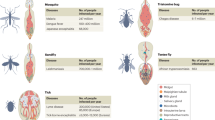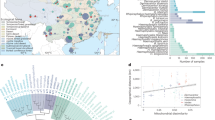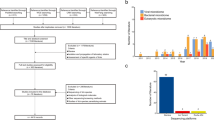Abstract
Lyme disease, a zoonotic disease, is the most prevalent vector-borne disease in the Northern Hemisphere. Diversity of the vector (tick) microbiome can impact pathogen transmission, yet the biotic and abiotic factors that drive microbiome diversity are largely unresolved, especially under natural, field conditions. We describe the microbiome of Ixodes pacificus ticks, the vector for Lyme disease in the western United States, and show a strong impact of host blood meal identity on tick microbiome species richness and composition. Western fence lizards, a host that is refractory to the Lyme disease pathogen, significantly reduces microbiome diversity in ticks relative to ticks that feed on a mammalian reservoir host. Host blood meal-driven reduction of tick microbiome diversity may have lifelong repercussions on I. pacificus vector competency and ultimately disease dynamics.
Similar content being viewed by others
Log in or create a free account to read this content
Gain free access to this article, as well as selected content from this journal and more on nature.com
or
References
Caporaso JG, Kuczynski J, Stombaugh J, Bittinger K, Bushman FD, Costello EK et al. (2010). QIIME allows analysis of high-throughput community sequencing data. Nat Methods 7: 335–336.
Carpi G, Cagnacci F, Wittekindt NE, Zhao FQ, Qi J, Tomsho LP et al. (2011). Metagenomic profile of the bacterial communities associated with Ixodes ricinus ticks. PLoS One 6: e25604.
Cheng D, Vigil K, Schanes P, Brown RN, Zhong J . (2013). Prevalence and burden of two rickettsial phylotypes (G021 and G022) in Ixodes pacificus from California by real-time quantitative PCR. Ticks Tick Borne Dis 4: 280–287.
Christian N, Whitaker BK, Clay K . (2015). Microbiomes: unifying animal and plant systems through the lens of community ecology theory. Front Microbiol 6: 869.
Eisen RJ, Eisen L, Lane RS . (2001). Prevalence and abundance of Ixodes pacificus immatures (Acari: Ixodidae) infesting western fence lizards (Sceloporus occidentalis in northern California: Temporal trends and environmental correlates. J Parasitol 87: 1301–1307.
Gosalbes MJ, Abellan JJ, Durban A, Perez-Cobas AE, Latorre A, Moya A . (2012). Metagenomics of human microbiome: beyond 16s rDNA. Clin Microbiol Infect 18: 47–49.
Hawlena H, Rynkiewicz E, Toh E, Alfred A, Durden LA, Hastriter MW et al. (2013). The arthropod, but not the vertebrate host or its environment dictates bacterial community composition of fleas and ticks. ISME J 7: 221–223.
Hughes GL, Dodson BL, Johnson RM, Murdock CC, Tsujimoto H, Suzuki Y et al. (2014). Native microbiome impedes vertical transmission of Wolbachia in Anopheles mosquitoes. Proc Natl Acad Sci USA 111: 12498–12503.
Hunter DJ, Torkelson JL, Bodnar J, Mortazavi B, Laurent T, Deason J et al. (2015). The Rickettsia endosymbiont of Ixodes pacificus contains all the genes of de novo folate biosynthesis. PLoS One 10: e0144552.
Jumpstart Consortium Human Microbiome Project Data Generation Working Group. (2012). Evaluation of 16S rDNA-based community profiling for human microbiome research. PLoS One 7: e39315.
Kuo M, Lane RS, Giclas PC . (2000). A comparative study of mammalian and reptilian alternative pathway of complement-mediated killing of the Lyme disease spirochete (Borrelia burgdorferi. J Parasitol 86: 1223–1228.
Lane RS, Loye. JE . (1989). Lyme disease in California USA interrelationship of Ixodes pacificus (Acari: Ixodidae) the western fence lizard Sceloporus occidentalis and Borrelia burgdorferi. J Med Entomol 26: 272–278.
Lane RS, Mun J, Eisen RJ, Eisen L . (2005). Western gray squirrel (Rodentia: Sciuridae): a primary reservoir host of Borrelia burgdorferi in Californian oak woodlands? J Med Entomol 42: 388–396.
Lane RS, Quistad GB . (1998). Borreliacidal factor in the blood of the western fence lizard (Sceloporous occidentalis. J Parasitol 84: 29–34.
Narasimhan S, Rajeevan N, Liu L, Zhao YO, Heisign J, Pan J et al. (2014). Gut microbiota of the tick vector Ixodes scapularis modulate colonization of the Lyme disease spirochete. Cell Host Microbe 15: 58–71.
Rynkiewicz EC, Hemmerich C, Rusch DB, Fuqua C, Clay K . (2015). Concordance of bacterial communities of two tick species and blood of their shared rodent host. Mol Ecol 24: 2566–2579.
Swei A, Briggs CJ, Lane RS, Ostfeld RS . (2012). Impacts of an introduced forest pathogen on the risk of Lyme disease in California. Vector Borne Zoonot Dis 12: 624–632.
van Treuren W, Ponnusamy L, Brinkerhoff RJ, Gonzalez A, Parobek CM, Juliano JJ et al. (2015). Variation in the microbiota of Ixodes ticks with regard to geography, species, and sex. Appl Environ Microbiol 81: 6200–6209.
Weiss B, Aksoy S . (2011). Microbiome influences on insect host vector competence. Trends Parasitol 27: 514–522.
Williams-Newkirk AJ, Rowe LA, Mixson-Hayden TR, Dasch GA . (2014). Characterization of the bacterial communities of life stages of free living lone star ticks (Amblyomma americanum. PLoS One 9: e102130.
Zhang X, Yang Z, Lu B, Ma X, Zhang C, Xu H . (2014). The composition and transmission of microbiome in hard tick, Ixodes persulcatus, during blood meal. Ticks Tick Borne Dis 5: 864–870.
Zolnik CP, Prill RJ, Falco RC, Daniels TJ, Kolokontronis SO . (2016). Microbiome changes through ontogeny of a tick pathogen vector. Mol Ecol 25: 4963–4977.
Acknowledgements
We thank Caitlin Miller and Betsabel Chicana for field and laboratory assistance. We thank Frank Cipriano for technical support for sequencing assistance. This research was supported by an NSF grant #1427772 and CSUPERB New Investigator Grant to AS. The microbiome sequence data are archived at Sequence Read Archive under the BioProject ID PRJNA352452.
Author information
Authors and Affiliations
Ethics declarations
Competing interests
The authors declare no conflict of interest.
Additional information
Supplementary Information accompanies this paper on The ISME Journal website
Rights and permissions
About this article
Cite this article
Swei, A., Kwan, J. Tick microbiome and pathogen acquisition altered by host blood meal. ISME J 11, 813–816 (2017). https://doi.org/10.1038/ismej.2016.152
Received:
Revised:
Accepted:
Published:
Issue date:
DOI: https://doi.org/10.1038/ismej.2016.152
This article is cited by
-
A review of filarial nematodes parasitizing tick vectors: unraveling global patterns in species diversity, host associations, and interactions with tick-borne pathogens
Parasites & Vectors (2025)
-
Microbiome variation between male and female Hyalomma dromedarii ticks from camels in the UAE
Scientific Reports (2025)
-
Exploring the microbiomes of camel ticks to infer vector competence: insights from tissue-level symbiont-pathogen relationships
Scientific Reports (2025)
-
Diversity of the Ixodes ricinus Microbiome Across Belgian Ecoregions and Its Association with Pathogen and Symbiont Presence
Microbial Ecology (2025)
-
The Microbiome and Coxiella Diversity Found in Amblyomma hebraeum and Dermacentor rhinocerinus Ticks Sampled from White Rhinoceros
Microbial Ecology (2025)



